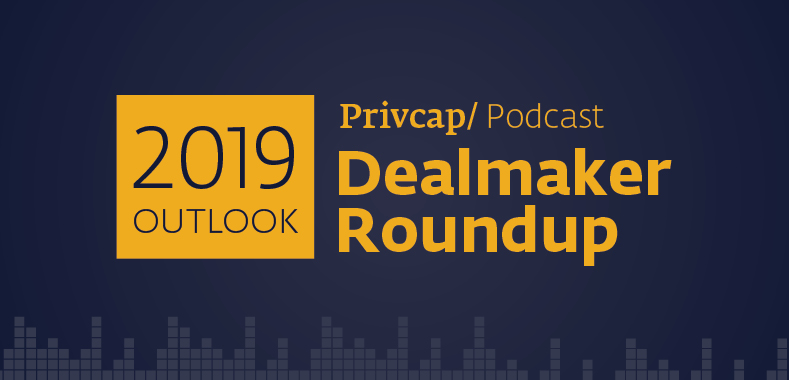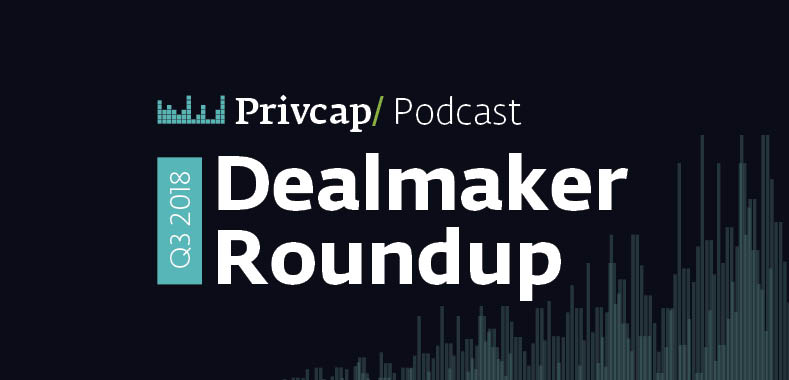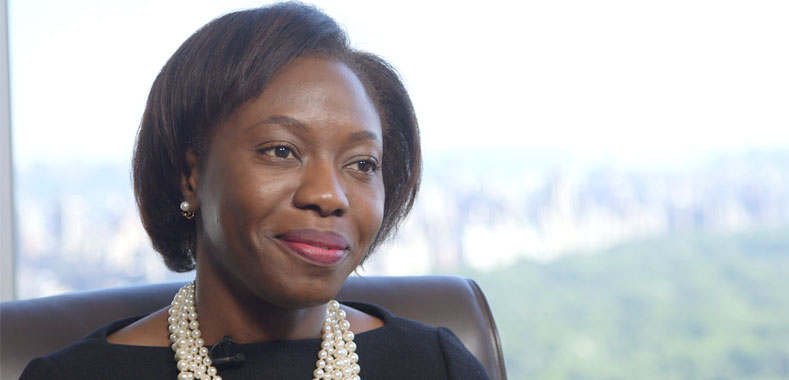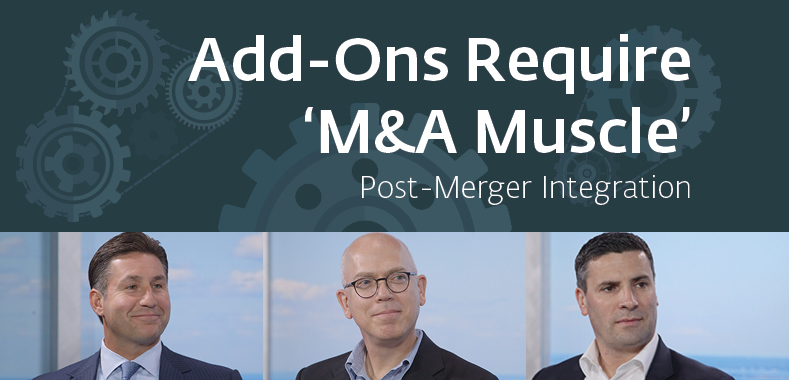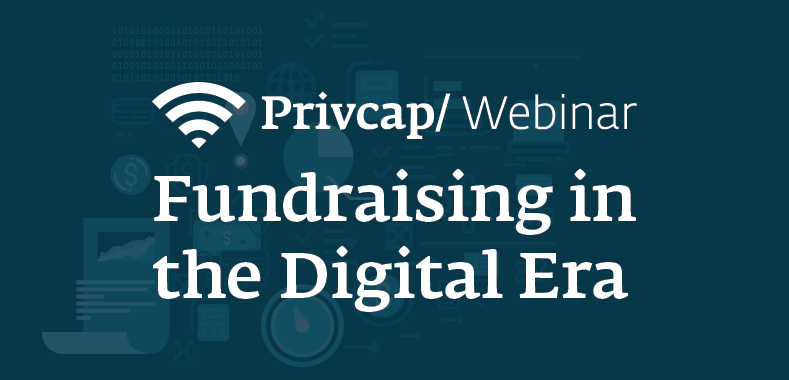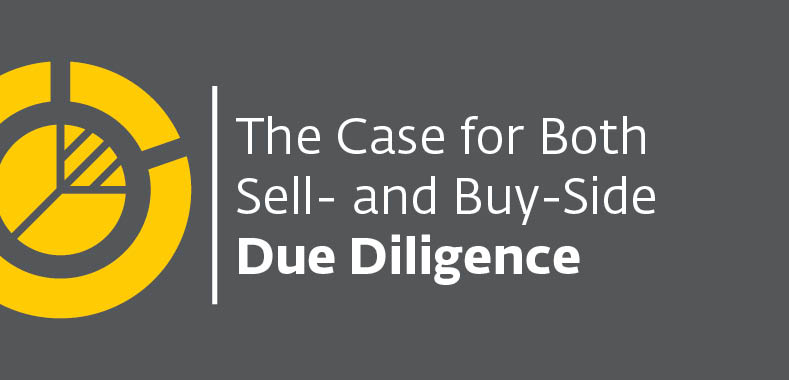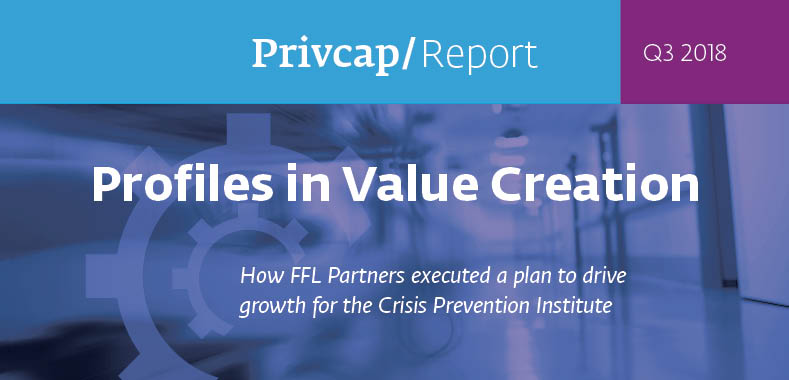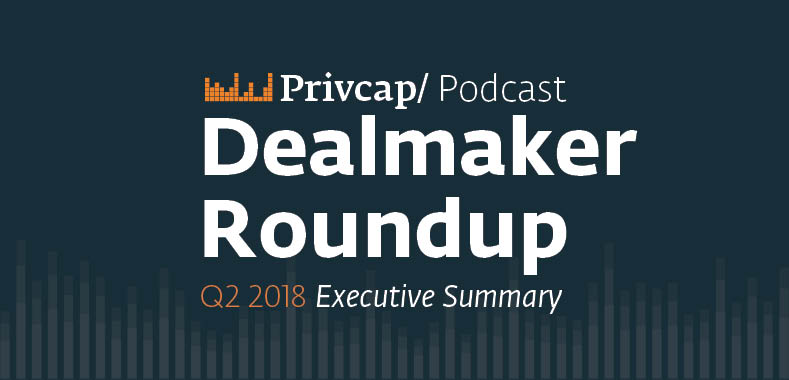Podcast: Dealmaker Roundup Q2 2018
Hiter Harris of Harris Williams & Co., Christopher Elvin of Preqin, and Michael Fanelli of RSM give their insights on the highlights of 2018’s second quarter. Listen to this podcast with complementary infographics, bringing a deep dive into current deal activity and close examination of capital raising trends.
Transcript Download Transcript
Privcap Podcast: Dealmaker Roundup | Q2 2018
Matthew Malone, Privcap:
Welcome, everyone. This is the Privcap Podcast. Today, we’ll be talking about the Q2 deal and fundraising numbers for private equity provided by our friends at Preqin. We have three great experts today to comment on the recent trends. First, we have Hiter Harris, from Harris Williams and Co. Welcome, Hiter.
Hiter Harris, Harris Williams & Co.:
Thank you. Thanks for having me.
Malone: We have Chris Elvin from Preqin. Hi, Chris.
Chris Elvin, Preqin:
Hi, good to be here.
Malone: And Mike Fanelli from RSM. Welcome, Mike.
Michael Fanelli, RSM US LLP:
Thanks, Matt. Very much, appreciate it.
Malone: First, I just want to give our guests a brief moment to give an introduction on their background. Hiter, from Harris Williams, if you would just give the audience a bit about your business and background, please.
Harris: Sure. I’m a managing director and co-founder of the firm. I founded the firm back in 1991 and we have grown and have a lot of great people with us. We’re M&A advisors, we have eight offices in the U.S. and Europe, 10 industry groups and over 300 people, and enjoying this brisk market.
Malone: Great, thank you. Chris Elvin, do you want to give a bit of your background, please?
Elvin: Absolutely. I’m the head of private equity products at Preqin, where I’ve been for roughly approaching 12 years. We’re an independent data provider focused solely on alternative assets where we collect data from a variety of sources, which we compile into our products and research and insights that’s relied on by about 60,000 in the industry professionals globally.
Malone: Great. Thank you Chris. And Mike Fanelli?
Fanelli: Yes, thanks Matt. Mike Fanelli, Transaction Advisory Services partner at RSM. I lead our New York practice. Our Transaction Advisory Services group focuses on buy-side and sell-side due diligence for M&A transactions. Our group is the largest Transaction Advisory Practice that is 100% dedicated to the middle market. And, for the past 12 months, we worked on approximately 600 due–diligence projects, a combination of both buy-side and sell-side. Approximately 70% buy-side and 30% sell-side, so I have a good pulse on what’s happening in middle marketing M&A and specifically private equity.
Malone: Great. Thanks, gentlemen. Let’s get right into it. Let’s start with the deal numbers for the second quarter of 2018. It looks like we are largely continuing a trend that’s been going on for a few years now. The top line numbers we had 1,149 deals in the quarter at $118 billion of value. That’s in line with the prior quarter and up a bit over the year earlier, so it looks like we’re fairly in a status quo, but certainly a busy time for deals. One question I have starting off is about valuations. This is a story that’s been playing out and being discussed in the past couple of years, but how does that look to be impacting deal volumes, or what is the view today about the state of valuations and how they might influence the deal market going forward? Hiter, maybe start it with you?
Harris: Sure. There’s no denying that prices in this market are at a cyclical high. We see this typically in this part of the cycle, but the market is also very active. The thing that people need to understand with the higher prices, though, is that it will bring down theoretical returns. But companies in this environment are growing at a pace that we just haven’t seen in the last five, seven, eight years. That does help the returns and helps particularly private equity outperform the returns that they’re estimating in the models. But, also, they’re really benchmarking themselves off the public markets. When LPs invest in this asset class, they’re looking to outperform the public markets and that spread is still there. So, even though prices are high, buyers are being well-rewarded for the investments they make and, of course, sellers are finding it to be a nice environment as well.
Malone: Mike Fanelli, are you seeing, at least with your clients, that that economic growth story is certainly true, meaning that while valuations are high, business is good and expectations are high so that the impact of those valuations on investment returns may be muted relative to what they might be in the past?
Fanelli: Yes. It’s a little bit of both, right? It’s almost the tale of two markets because there are some really good growth stories out there in the marketplace but there’s also a tremendous amount of capital chasing mediocre growth business as well, so it’s kind of interesting, but because the really high–growth companies are obtaining extremely high valuations, but what I would call mediocre–growth companies are getting a lot of activity from private equity and still higher than normal or at least historical valuations as well. At the end of the day, I think the capital has been allocated and raised within the private equity sector and has to be put to work. Overall, the valuations are high, but we’ve been saying that for the last three years now, I think. So, it’s a bit of the new normal now and I do think that our expectations may be lowered for the future. I think it’s still a great place to play and still the alternative asset class continues to see incremental capital being put into it. And especially on the deal volume side, deal volumes seem to be here to stay as well because of increase in add–on activity in the marketplace. Now, add-ons is really where you see the high volumes, but also seeing some differentiation between total value on a quarter-to-quarter basis and total volume on a quarter-by-quarter basis could be different, just because of the really large deals that happen versus the high number of smaller deals that happen.
Malone: Thanks, Mike. Chris, do you think this trend, at least in the near term, is to continue? Do you have any sense, at least from frequent clients or your understanding of these markets, that we should expect a drop-off in deal activity, and/or valuations any time soon?
Elvin: To echo much of what Hiter and Mike have said already – and they’re obviously at the sharp end of the stick from a deal point of view – from looking at the data and what we’ve seen is despite these valuations, which are conditions that are common to most asset clauses today, looking at private equity buyout deal volume, for example, is actually being fairly consistent for a number of years, with around 1,100 deals or so done each quarter. In fact, Q4 2017 and the first two quarters of this year have actually seen an increase, where we’re closer to 1,200 deals done.
The reality, and there’s no getting away from this and our survey results show this, the point that Hiter made, is there has been some adjustment in terms of LP expectation. Private equity is actually very well-positioned with the longer-term investment horizon, even in times of economic downturn, and has a history of continuing to outperform public markets. But, when we look at the proportion of LPs, in term of level of out-performance that they’re expecting longer term, there has been a slight reduction in those percentages, suggesting the reality that perhaps the returns will be slightly lower. But I think there’s still a strong belief that the out-performance will be there. Certainly, when we ask GPs about the level of capital they’re looking to commit, by comparison to the last 12 months, the overwhelming trend is they’re looking to invest the same levels, if not more, in 2018 than they did in 2017.
Harris: Just a note, I think Mike and Chris are absolutely right that people talk about how elevated prices are inactivity, but we’ve been in this environment for quite a while. I remember conversations I had in 2014 with private equity about how hard it was to find companies, how elevated prices were, how they were tempted to sit on the sidelines for a while. But we’re now selling the companies that were invested in 2014 and some of those returns are some of the best that we’ve seen for decades.
If you had sat on the sidelines during that period, you wouldn’t have benefited from those returns. We could find that the same environment exists this year.
Malone: Great. Thanks, Hiter. Let’s move on to some of the more micro data here in terms of industry. Healthcare had a good quarter, but seems like that may have been influenced by a big deal, which is KKR’s ongoing dollar buyout of Envision from CD&R. Do we see activity in healthcare remaining at an elevated level or do we think this is a one-off? I’ll start with you, Mike.
Fanelli: I don’t specifically focus in healthcare, but we have a dedicated healthcare team within our practice and they continue to see the growth in overall activity. KKR’s acquisition of Envision Health was a large one and definitely gave the healthcare stats some juice this last quarter. You’re going to see some of those in the news over the next year, I think, as well – some of the large deals in the healthcare sector. But, also, from a volume perspective, healthcare continues to be one of the higher levels of volume from a middle-market M&A activity perspective as well. It seems to be continuing, both presently and in the future.
Some of the things we do is on the sell-side, where investment bankers like Hiter and his team are calling us to work for a business to help them prepare for sell. We’re getting a lot of those calls right now, too, so I would think that the rest of 2018 would be a relatively high volume for healthcare as well. Some of the strong activity seems to be coming from certain sub-sectors like long-term care, managed care and also some specialty services. We get a tremendous amount of fragmented roll-up strategies within the likes of dermatology practices and dentistry roll-ups.
Malone: Hiter, is that consistent with what you’re seeing in the pipeline? This healthcare – it’s been an active sector and you can see that trend continuing?
Harris: Very much so. We have a large presence in the healthcare world and we’re really seeing this as a period of consolidation, broadly speaking, in the healthcare world. A lot of those sub-sectors are still very, very fragmented. But even in the bigger companies, we’re seeing consolidation. There are consolidation trends with hospital systems. There’s a much larger trend of horizontal mergers, when you think of companies like Aetna and CVS getting together. Cigna and Express Scripts, even Amazon and PillPack. All these are horizontal consolidations that are really changing the face of the healthcare world.
Then, you look at things like the Envision deal that Mike mentioned. That’s another trend of hospital-based clinical outsourcing companies that we think we’re in the beginning of seeing a lot of those transactions. If you look back two or three years ago, there was a lot of conversation about reimbursement and some weaknesses in certain sectors of the healthcare market. We’re not seeing that anymore and we think the volume is really going to pick up.
Malone: Chris, this is a consistent trend in the data, right? In terms of volume in healthcare, the dollar volume may be affected by this one large deal, but healthcare is something that has been popular and will likely to continue to be so, correct?
Elvin: Yes. Again, you look at the tailwinds and healthcare remaining an important sector for private equity focused investments. Those tailwinds of a globally growing, aging population, as well as other factors such as regulatory change and particularly linked to technological innovation, you couple all of those elements together and it undeniably leads to healthcare presenting good opportunities for private equity investment and playing a continuingly significant, if not growing, role in this wider private equity deal activity.
Malone: Great, thanks. I think another interesting industry, at least this quarter, is industrials. It saw about a quarter of all deal volume. I read earlier this week that industrials just closed a $1 billion-plus fund, hitting their hard cap, giving some indication about the popularity of that market. Hiter, are you seeing a lot in industrials? What’s going on there in terms of the pick-up?
Harris: We are. You really have to break industrials down in a couple of different ways. First, the sub-sectors. Industrials is a huge industry, but in the sub-sectors you look at packaging, you look at chemicals, you look at aggregates and other materials and they’re all very, very active. A lot of the dynamics are the same. Again, if you turn back the clock to 2015 or 2016, a lot of the industrial spaces just weren’t growing very much. Some even called it the industrial recession. But that’s not the case today. Companies are growing at a very good pace, broadly speaking.
But you also overlay some specialty sectors, such as what we call the Internet of Things. I know that’s a buzzword, but if you think about what that means, it’s really putting sensors and different measurement devices on mechanical equipment to give you information for efficiency, for safety, and we’re seeing huge trends in that space. There are lots of others in industrial. We think the next couple of years are going to be very bright for industrials in almost all of the sectors, so it’s a good time.
Malone: Mike, what’s the RSM team seeing in this space? Are you seeing a lot of activity? Are you doing a lot of diligence work with industrial groups?
Fanelli: Yeah, a tremendous amount of activity. I’m glad Hiter spoke about the various sub-sectors. I’ll take it from a bit of a different approach, just from a more high-level perspective in terms of, as the overall economy just continues to roll on and has been since call it 2011, it seems like industrial products – broadly speaking, those companies have benefited from the overall growth in the economy. There seems to be a significant number of especially middle–market private equity investors who have some type of operational expertise and that focus on investing in industrials. Because of that, the industry sees a lot of activity from PE.
These businesses tend to be – not always, but tend to be – mostly diversified in terms of client-based and product-based. But, also, many times have room for improvement when it comes to various operational matters. Private equity tends to come in and seize – actually, here’s the buzzword of value creation. This is one of those industries from a broadly speaking industry perspective, there’s a lot of room for value creation on the margin perspective, where they may be able to change the fixed-cost operating structure of the business. They may be able to improve gross margins by changing the efficiency of the supply-chain and/or the plant, etc. So, private equity can come in if they have that experience, can come in and really show that value-creation thought process for these middle-market businesses.
Again, similar to healthcare, although we might be able to say this about many industries right now, a lot of the sub-sectors within industrial products are very fragmented and ripe for consolidation, so when we’re on the buy-side, and let’s say Hiter’s on the sell-side … you look at a sim of an industrial products business they may have 20 potential future add-on acquisitions already identified, or a buyer saying, “By the way, here’s our growth story,” but also … there’s more of the apple to bite off here for a future buyer. Which seems to be another reason that it’s a hotbed for PE activity.
Malone: Excellent, thank you, Mike. Let’s move on to the other side of the coin here, which is fundraising, which we certainly saw some interesting developments in the last quarter. Chris, do you want to walk us through a bit of what’s going on with PE fundraising?
Elvin: Yes, certainly. I think there’s always a word of caution when, looking at quarterly stats, and whether it’s sort of a longer-term trend or simply a blip or a wind down in activity. And, as many people will attest to, we really are in an unprecedented period of private equity fundraising. I think when you look at aggregate activity over the years, it’s now the fifth consecutive year in which more than $300 billion has been raised by private equity funds. Even going back to the pre-crisis in the last buyout boom, there were only three quarters – sorry, three years – in which that happened previously, so it’s still very much an attractive fundraising environment, but what we saw in Q2 was a slowdown in activity and the lowest levels in seven quarters.
But I think the importance made the point that levels are still very much on par or in excess of the levels seen each quarter in 2015 and 2016. The prime cause of that was really slightly slower buyout activity in the quarter compared to previously, but, as I say, still very much a thriving fundraising environment. From our perspective, one of the key bits of data that we look at, and the driver of the stellar fundraising that’s been seen year on year, is the levels of if we take aggregate capital calls and distributions to LPs and analyze that, back in 2011, there was actually a remarkable thing happening where the flow of capital in the industry switched, with aggregate distributions outstripping capital calls for the first time. And that hit new highs in 2014, 2015 and 2016, when you look at the wide private capital universe, including real estate and direct lending and private debt and so on.
When you look at the difference between the capital distributions and capital calls, pretty much in each of those years you saw net distributions to LPs of about $150 billion, so an absolute tidal wave of capital going back to LPs. We now have full–year 2017 data and actually from those three consecutive years of about $150 billion going back to LPs, it was actually about $36 billion last year, so a significant reduction.
Now, that doesn’t change the fact that LPs are still incredibly liquid, the fundraising environment is still very attractive. Many investors looking to continue to invest as they look to maintain their allocations, but we did see a slight reduction in Q2 and there are perhaps some wider industry trends that we all know were in the later stage of the cycle, but maybe … there’s some proof coming forward in the evidence of some of these stats now.
Malone: So, we need a few more quarters to see if folks should really start worrying. There still are certainly plenty of GPs out there trying to raise capital, but in your view, this is sort of wait and see, and it may not be at least cause for immediate concern.
Elvin: Yes, absolutely. There are more funds than ever in market-raising capital, and I think it’s probably at bit early to say we’re on the verge of a correction or anything … I still expect fundraising in 2018 to still be very strong. Yes, it may not be quite at the levels that we’ve seen in the last few years, but as I say, we really are in an unprecedented period for fundraising.
Malone: Hiter, is that sort of consistent?
Harris: Yes. There are so many facets to the trends that are going on right now. First of all, the data that’s available now to discuss, just like Chris did, is remarkable. I really salute Preqin and how they’re able to slice and dice this data.
But you also have to be careful of making too many sweeping predictions with short–term data, particularly on a quarter–by–quarter basis. At best, you need to look at an annual basis and really more likely on the asset allocation review basis for LPs, because that’s really where it starts.
When you have, for example, a $100–billion pension fund that’s moving their private equity allocation from 5% to 8%, just think about it, that’s a 3% difference. That’s $3 billion, but that means they have to commit $5 to $6 billion just to get to that asset allocation. That’s huge, and if you have an entire industry doing that, you’re pumping an incredible amount of supply into the system. At the same time, even though the number of private equity groups are growing, the capacity that they have to absorb that capital is still somewhat limited. Good private equity firms are raising money very quickly.
I remember in the old days it would take 18 months to raise a fund, private equity groups would have to go out on the road and make 100, 200 or 300 visits to get that. Now, today, they’re oversubscribed and they never leave their office and that shows you how far that has come. But it’s always going to be a supply demand factor and, right now, there’s a lot of money and the private equity world is trying to grow to absorb that. And I think it will continue to do so.
Malone: Excellent. Mike, you sit in this world between GPs and portfolio companies. Are you hearing anything? Again, I think it goes without saying that this quarterly data could very well be misleading, but anything you’re hearing from your clients or groups that you work with on the fundraising side?
Fanelli: Yeah, mostly consistent with what’s already been said, but dry powder is at an all-time high. From a more longer–term perspective to Hiter’s point, the fundraising totals for Q2 are not necessarily low.
Are they lower than certain other quarters from the last two to three years? Yes, but from a longer term horizon are the Q2 numbers low? Not really.
The other way to think about it the fundraising activity of the last two to three years, maybe that wasn’t even really sustainable because now it’s all got to be put to work and, to Hiter’s point on the capacity of current state private equity to be able to take in all of that capital and to put it to work, needs to right–size itself.
The one thing I would say is I can’t figure out how it’s going to affect fund raising over the next year or two, but I was speaking to a few private equity firms recently in an informal setting and they are starting to have conversations with LPs about their next fund. They’re not fully invested in their current fund yet, but starting to have some conversations and the correction, the R-word of recession and or correction, is being thrown around by limited partners, in terms of the next 24 months.
It’s hard to talk about, but they have to think that way. It’s hard to talk about right now because everything is so good from all the data points you could think about from a global economic perspective, but there’s obviously some macro things that could change that.
I think the interesting thing always is that limited partners are going to be investing x amount of their total capital, like Hiter was mentioning, changing from 5% to 8% for a pension fund. They’re going to be putting some level of capital into alternative investments as a diversification tool, and then private equity within alternative investments.
And they’re expecting their private equity GPs to invest over these 10-year horizons, which is typical – the average fund is about a 10-year fund. So, it’s almost like they have to invest when times are good. They have to invest when times are not as good, so I think it’s becoming more of an industry, more of a dedicated kind of capital allocation pool to be able to provide businesses a tool to grow, expand, sell, etc.
Malone: Thank you, Mike. Unfortunately, we are out of time today, but I did want to thank our guests Hiter Harris from Harris Williams, Chris Elvin from Preqin, and Mike Fanelli from RSM. Hoping to have you all back on the program in the future, and thanks to the audience for listening.
Fanelli: Thanks very much, Matt.
Harris: Thank you, Matt.
Elvin: Thanks, Matt.





